HENRY TERRELL, News Editor
Advances in new drill bit technology moved at an accelerating pace in the past year, as engineers continued to design bits to drill larger, higher-quality holes with better rates of penetration and more control. Shale is still on operators’ minds, and PDC bits are still the tool of choice.
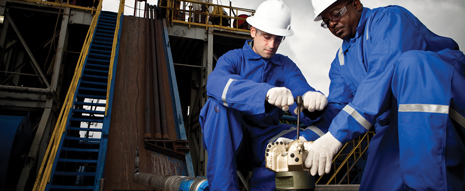 |
| Pathfinder engineers prepare to pick up a Smith Bits Spear drill bit with Onyx II PDC cutters. Photo courtesy of Schlumberger. |
|
Since every trip to replace a bit adds significantly to time and well cost, the focus of new bit technology has been on increased durability, reduced bit erosion and longer runs, whether drilling the vertical, curve or lateral section. As in previous years, several records fell in the categories of both shortened time and increased distance drilled without pulling to surface.
Developments were made in bit customization—it is becoming more and more common to utilize bits that are tailor-made for the particular well. Cutting structure, geometry and other parameters are customized to fit formations encountered and desired well characteristics, and improvements in design software have enhanced efficiency and turnaround time. Rotary steerable systems (RSS) have also driven improvements in bit design.
Roller-cone bits are still a viable choice for many wells, and better, more abrasion-resistant materials are available for robust cutting and high rates of penetration (ROP). Large diameters and greater power requirements have created the need for increased lubricant volumes and larger grease reservoirs. As with PDC bits, designs are adjusted to match the operating requirements and the needs of steerable systems.
There is a small but growing market for drill bits used in non-petroleum drilling, notably geothermal, with its own particular demands. Extremely hard formations and temperatures greater than 350°F have led to increased research into seal configurations and thermally stable greases that can withstand geothermal environments.
Finally, hybrid drill bits, combining the characteristics of roller-cone and PDC technology, are finding increasing use in large-diameter and directional drilling situations.
BAKER HUGHES
Baker Hughes uses its cross-functional drilling application review team (DART) process to develop products that are optimized for a given application. Novel designs are first tested through computer models and then in the drilling simulation lab. In recent years, this process for new product development has led to significant advancements in the company’s drill bit platforms, including the Hughes Christensen Quantec Force PDC drill bits, Vanguard Tricone roller-cone drill bits and Kymera hybrid bits.
Baker Hughes’ new TBD high-efficiency vector-accurate PDC bit is designed to drill shale plays efficiently by penetrating their curve and/or lateral hole sections with higher ROPs, desired build rate and longer life—all with a high-quality borehole. With its improved hydraulic efficiency, the bit is optimized for use in low-hydraulic-energy situations. The product line consists of a PDC frame that is designed specifically for each application and approved by the DART team.
Applicable in unconventional shale plays, the drill bit employs optimally designed junk slots that aid large-volume evacuation of cuttings material. Efficiently shaped and positioned blades, nozzles and proprietary polished cutters increase capacity and flow of cuttings, and resist packoff incidents to keep up the desired ROPs. Enhanced durability and reliability reduce bit erosion, while maintaining good directional control. The combination of torque-management technology with DART-approved gauge design improves steering capability.
In the Haynesville shale, Baker Hughes used a 6¾-in. drill bit for an operator seeking to improve its drilling time through the curve and lateral sections in an interbedded formation. The drill bit was able to increase hydraulic efficiency, converting a traditionally two-bit interval run into one fast run—drilling up to 41% faster and 181% farther than direct offsets.
Baker Hughes’ Kymera hybrid drill bit (Fig. 1), which was launched in fourth-quarter 2010, continues to show promise in a number of applications, including interbedded formations, chert or basalt, large-diameter applications and directional drilling. Historically, fixed-cutter and roller-cone designs have been contradictory in nature, and operators were compelled to sacrifice one characteristic for another between the two designs—usually ROP vs. durability. However, Kymera bits use a rolling torque-management system, which combines fixed-cutter and roller-cone cutting elements to bridge the application and performance gap between the two solutions.
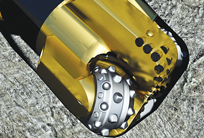 |
| Fig. 1. Baker Hughes hybrid drill bits combine roller cones and PDC fixed cutters into a single design with the rock-crushing strength and stability of roller cones and the continuous shearing action of PDC. |
|
Previously, in a market where drilling harder rock with PDCs was the primary concern, Quantec Force PDC drill bits (Fig. 2) were able to accomplish that goal with highly durable and steerable PDC frames. As the market continues to evolve, customers are looking for drill bits to deliver faster ROPs with tougher cutters, as well as a consistency of performance while maintaining good directional control.
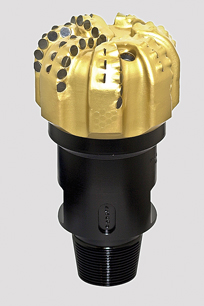 |
| Fig. 2. The Baker Hughes Quantec Force uses cutters for the most challenging applications. Force-distribution design practices provide stability to protect the cutting structure for longer durability. |
|
In early 2012, Baker Hughes plans to introduce a new product line that achieves those characteristics with what could be the fastest PDC frames available. Also, a new series of abrasion-resistant and impact-resistant cutters will be introduced to handle diverse lithologies that are more common in today’s shale play markets, where the number of bit trips must be minimized.
NATIONAL OILWELL VARCO
With the growth of directional drilling and the large diversity of drive types encompassing both RSS and positive displacement motors (PDM), there is increasing need for specifically optimized drill bits for these applications. Drill bit design, however, is only one piece of the puzzle. Bits must be fitted with the correct cutter technology to address abrasive resistance, thermal resistance or impact damage due to high torsional and lateral vibration.
The ReedHycalog Seeker directional drill bit product line from National Oilwell Varco (NOV) Downhole (Fig. 3) recognizes that a single drill bit design will not work for every drive type and well profile. Cutting structure, profile, bit length and gauge geometry are customized based on interaction with directional tool suppliers and an understanding of the performance limiters for various well profiles.
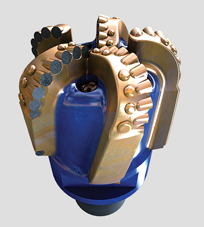 |
| Fig. 3. The NOV Downhole ReedHycalog Seeker Directional drill bit line has cutting structure, bit length, gauge geometry and other features customized for various well profiles. |
|
Bit selection is also one of the areas that has become very critical to overall drilling performance. To ensure consistent and accurate matching of the drill bit to specific drive type and trajectory, NOV Downhole has developed an interactive software tool for internal optimization of bit selection. The ReedHycalog SystemMatcher software incorporates logic regarding tool operation and trajectory requirements and assesses these against key characteristics of the drill bit, including bit length, profile, gauge geometry, cutting structure and side cutting capability. Combining this software with the right cutter for the application can result in greatly improved performance.
Since the introduction of ReedHycalog’s Helios Thermal Tough Cutters, a range of thermally abrasion-resistant cutters, many field records have been broken. The first three runs outside of North America each set new records in both ROP and overall run length. This technology combines high-density PDC material with the deep leach technology to significantly reduce cutter degradation and allow the bit to drill considerably farther and faster.
NOV’s initial perception that impact was the primary cause of cutter failure has been proven by research to be incorrect. Instead, it was discovered that failure is a complex progression driven by thermal abrasion. Seeker drill bits in conjunction with NOV Downhole’s Helios Thermal Tough Cutters have outperformed previous designs, setting many field records. Modeling the rock interaction utilizing finite-element analysis (FEA) together with the thermal tough cutting technology, engineers have significantly improved overall bit performance, in many cases enabling operators to reach TD with one bit.
Performance results. An 8½-in. Seeker bit with Helios cutters, in combination with an RSS, successfully drilled a main bore and three openhole sidetracks without pulling to surface for a total of 15,836 ft, setting a new field interval record. The formation was predominantly Sognefjord, which consists of medium-to-course-grained sand with hard calcite stringers. The Seeker bit drilled a 12.2% longer interval than the longest competitor run and set a new field interval record on Troll field. Great directional control, requiring less steering force than offsets, was reported. The bit had exceptional durability, considering the interval drilled, and an excellent dull grade.
Roller-cone improvements. The ReedHycalog TuffCutter line of roller-cone bits are made using a patented powder forge process in which powdered metal is heated and pressed into a fully densified structure. NOV Downhole pioneered the application of this technology to drill bits, and the company continues to advance the powder forging process, focusing on continuous development of materials that are more abrasion- and impact-resistant, providing a more robust cutting structure.
Most recently, NOV Downhole has utilized advanced computational fluid dynamics (CFD) and improved material design to enhance the effectiveness of the TuffCutter line. One example of this improvement occurred in the Pinedale Anticline field, an extremely abrasive sandstone and siltstone area. The objective was to drill out an 8½-in. section beginning around 800–1,200 ft and continuing through the abrasive sandstone formation to about 5,000 ft. The resulting run set an intermediate section record. The TuffCutter TC11 CP drilled 4,070 ft at 246.7 ft/hr vs. the average offset run of 3,828 ft at 147.5 ft/hr, representing a 67% ROP improvement over the average offset.
SMITH BITS
Smith Bits, a Schlumberger company, has continued development of synthetic diamond technology, seeking to advance hard materials science and processes to expand the application of PDC bits into more challenging applications. In 2008, Smith Bits introduced Onyx PDC cutter technology for more efficient drilling in harsh formations.
A team of experts from manufacturing, product engineering and R&D were tasked to improve the durability of the original Onyx cutter. This initiative involved a detailed analysis of dull bit condition to document cutter wear, which provided critical information enabling materials scientists to develop new technology to enhance cutter life. This effort was matched by manufacturing specialists who focused on ways to improve diamond press technology to optimize the sintering process and improve diamond-to-diamond bonding. This approach led to the recent introduction of new Onyx II PDC cutter technology.
Bits equipped with the Onyx II cutter (Fig. 4) were compared against previous generations in a controlled laboratory environment. Using component testing facilities, engineers evaluated the cutter/rock interaction on specialized test equipment. To simulate harsh and abrasive drilling conditions, granite blocks were used to exacerbate wear conditions to clearly determine the cutter’s downhole characteristics. In direct comparison to the original Onyx cutter, the Onyx II bit displayed increased resistance to edge wear with significantly less chipping and spalling, Fig. 5.
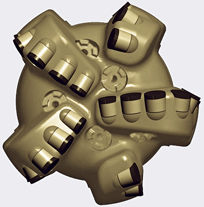 |
| Fig. 4. The Smith Bits 6-in. MDi516 equipped with Onyx II cutter enable PDC bits to drill more efficiently in harsh conditions. |
|
 |
| Fig. 5. Side-by-side comparison of an Onyx II (left) and Onyx cutter shows less chipping and degradation of the new cutter’s diamond after 300 passes on a granite block. Photo courtesy of Smith Bits, a Schlumberger company. |
|
With laboratory tests demonstrating the increased stamina of the new cutter, the next step was to validate these improvements in field test trials. Working closely with an operator to identify harsh drilling challenges, the Onyx II cutters were brazed into selected PDC designs for field testing. In an application in Sublette County, Wyoming, a 6-in. PDC bit (five blades, 16-mm cutters) outperformed an offset well drilled with original Onyx cutters. The new cutters enabled the bit to drill 4,775 ft in 78.5 hours at a rate of 60.8 ft/hr, compared to the 3,900 ft drilled in 79.4 hours at an average rate of 49.1 ft/hr with standard Onyx cutters. The Onyx II cutters also improved the bit’s dull condition and have delivered estimated cost savings in the application of $850,000 to $1 million per rig per year.
Geothermal. In geothermal drilling, operators face the daunting challenge of penetrating igneous and metamorphic lithologies, including granite and schist. Adding complexity to the drilling challenge is high downhole temperature in excess of 350°F, which can severely reduce bit life and increase drilling costs. In most cases, these hard and abrasive rocks are drilled with a roller-cone bit, but extreme heat reduces on-bottom drilling hours, leading to multiple bit runs that drive up development costs. Elevated downhole temperatures can also exist in deep oil and gas environments, as well as high-pressure/high-temperature (HPHT) wells. The industry requires new roller-cone technology that can endure the extreme downhole environment to increase on-bottom drilling hours while reducing total bit consumption and tripping for bit change out.
To solve the problem, Smith Bits launched a focused initiative to develop roller-cone technology specifically for geothermal applications. The project started with an engineering and research analysis to fully understand the complexity of downhole temperatures and pressures in geothermal wells. Armed with the knowledge gains, a structured effort was launched to develop seal materials and grease formulas that could withstand the rigors of the challenging downhole environments encountered in geothermal drilling.
The development efforts led to specialized fluorocarbon elastomer seal compounds and proprietary grease reservoir components. Specifically, the seals are made from fabric-reinforced materials that provide excellent thermal stability and wear resistance. Laboratory tests show the mechanical properties of the compounds to be well suited for high-temperature environments. To ensure adequate lubricity in the geothermal applications, an innovative high-temperature grease compound was developed from selected synthetic base oils, lithium and various functional additives to increase load capacity at elevated temperature. Lab test results show that the load capacity of the new grease holds consistent up to 500°F, whereas the standard grease load capacity dropped by 75% at 350°F.
The synergistic performance of the high-temperature sealing system was confirmed using a custom-designed test apparatus in an environment that accurately simulates downhole drilling conditions including rotational speed, temperature, pressure, drilling fluids and misalignment of the cone/leg. The new seals and grease formula were recently evaluated during a field test in a European geothermal application with very successful results. A total of three roller-cone bits, equipped with a single seal configuration, were used in the 8½-in. hole section to drill a hard and abrasive granite with average temperatures of 320°F–350°F, with spikes up to 570°F. The three bits demonstrated superior performance compared to standard roller-cone products and came out of the hole in good dull condition.
The last bit run set new field records of 76.5 hours on bottom and 300,000 total revolutions. Overall, the performance of the new seal and grease configuration had a positive impact on run lengths and produced an increase of up to 37% in the number of on-bottom drilling hours compared with the baseline offset bits. The development of a fit-for-purpose seal and grease system for high temperatures should greatly improve drilling efficiency in geothermal applications.
VAREL
In response to increasing demands being put on larger-diameter roller-cone bits, Varel International has introduced the High Roller series, Fig. 6. Available with either a mill tooth (left) or tungsten carbide insert cutting structure, these bits are offered in diameters ranging from 14¾ in. to 18½ in. The new line includes the company’s conical seal gland technology along with a new, larger lubricant reservoir that enables longer bit life in demanding applications.
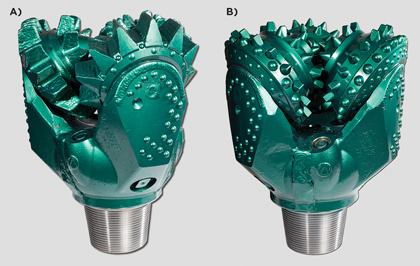 |
| Fig. 6. As the diameter of drill bits has grown larger, up to 18½ in., so have bearings and the need for better lubricants at higher volumes. Photos courtesy of Varel. |
|
Specifically, the conical seal gland positions the seal to better handle pressure fluctuations within the bearing while maintaining a preferred dynamic sealing interface. In addition, the overall seal dimension has been increased compared with previous large-diameter roller-bearing bits. To increase lubricant volume, a new, larger grease reservoir was designed for the series, driven by increased bearing size and energy requirements.
Along with the modified features of the bit, this series, like the High Energy series before it, offers benefits from greater understanding of bit design with a unique cutting structure design and spacing. Bit designers worked through computerized knowledge-based systems and formulas to tailor specific cutting structure designs to match the operating requirements demanded by modern steerable drilling systems.
As an example, a 17½-in. High Roller bit recently achieved excellent results in a North Sea application. The bit was selected as the first bit in a two-bit plan, with the goal of drilling the initial 1,300 ft of an interval through the Balder (pyrite) formation, to be followed by a fixed-cutter bit. After drilling the initial 1,300 ft, the ROP was greater than expected. Consequently, the customer decided to drill ahead in lieu of tripping out of hole to replace the bit. The High Roller bit continued to complete the entire planned section of 5,446 ft with an average ROP of 62.3 ft/hr.
PDC advances. Varel engineers have developed a bit specifically for shale applications, particularly the Marcellus and Eagle Ford shale plays. The bit, nicknamed the Hole Monster by rig personnel, is part of the Navigator PDC product line and was reengineered to meet the sticky shale formation demands and directional requirements in these areas.
The bit is geometrically suited to build angle at high rates up to 18°/100 ft in order to fit the spectrum of directional applications. The design also features a shortened makeup length for control and steerability. Hydraulics, a known concern in shale formations, was addressed through CFD analysis. The resulting fixed port and nozzle pattern was developed to provide efficient cleaning of both the bit face and the hole bottom.
As operators increasingly demand the ability to build angle, drill the tangent and make the lateral section with one bit, longevity remains the primary goal of the design. This bit’s design attributes allow it to achieve extended life.
Engineers pushed the boundaries of blade height-to-width ratio for matrix bits. In addition to the new geometry, materials engineers examined the matrix/binder combination to make sure that the optimum combination was achieved for the application.
In one South Texas application, the operator requested the five-bladed 83/4 in. Hole Monster to drill the curve and the lateral on the same bottomhole assembly. After completing the curve in 19 hours with an average ROP of 41.4 ft/hr, the bit continued to drill 2,008 ft of lateral in 18.5 hours with an average ROP of 112.9 ft/hr. The bit was tripped out of hole for a BHA change to a lateral assembly, and rerun.
This same design produced similar results in a northern Pennsylvania lateral section. The bit drilled 4,876 ft in 53.5 hours, the fastest lateral on this rig, at an average ROP of 91.4 ft/hr.
Future developments. As the majority of the market has shifted to PDC products, Varel has been expanding research and development, supported by a new R&D laboratory in Houston. Following the introduction of PDC cutter testing methods late last year, the company has seen excellent success with the Acoustical Emissions Toughness Test (AETT), which quantitatively assesses the strength of PDC diamond-to-diamond bonding in laboratory settings.
DRILLMASTER INC.
The Sta-Bit from DMI is essentially a special stabilizer integrated with a PDC bit in a way that can provide unique radial (lateral) control of the bit. This design prevents chatter, whirl and other vibrations, thus greatly extending bit life. Particularly in hard rock drilling, bit durability increases exponentially in relation to stability.
The effective lateral control of the Sta-Bit also prevents deviation without the need for bottomhole assemblies.
When properly utilized in conditions where it provides advantages, drilling and tripping time per well can be reduced by 15–50% compared to conventional bits. Generally, the deeper the well being drilled, the more value the bit can provide.
Applications. Various Sta-Bit designs are suitable for a wide range of drilling applications:
-
Extremely hard or tough formations such as limestone, dolomite, hard sandstone and similar conditions, including pyrite and chert. The stabilizing features of the bit prevent vibration inherent in conventional PDC bits so that the Sta-Bit can maintain both sharpness and high ROP, and thus can drill more footage before dulling.
-
Extremely abrasive conditions such as sharp quartzitic sandstones. The Sta-Bit is equipped with diamond-capped wear inserts so that it does not experience significant wear.
-
Moderately tough conditions such as soft limestone, anhydrite, hard shale and similar conditions. The stabilizing features of the bit enable it to drill moderately tough formations with reduced cutter density.
-
Almost any formation condition—hard to medium—where deviation tendencies exist. The bit can maintain an optimum ROP while keeping deviation to less than 1° and does not require special steering tools or great reduction of WOB to avoid deviation.
The normal BHA when using the Sta-Bit is only one stabilizer 30 ft up from the bit. No other BHA is required.
The Sta-Bit can eliminate bit side-cutting tendencies; i.e., the bit drills the way it is pointed. Doglegs are eliminated, which in turn helps alleviate casing problems. Deviation can be prevented, saving the rental cost of extra downhole tooling needed to keep a straight hole. Also, whirl-induced patterns in the wellbore are eliminated, and hole tightness is reduced.
During directional drilling, steering is kept consistent and control is optimized, while sliding difficulties are minimized. In vertical drilling, there is no need for a mud motor, though one can be used if the driller prefers. Post-completion, straight holes help reduce sucker rod wear.
CONCLUSIONS
The greatest achievements in new drill bit technology have not been just in materials. New cutters, better metallurgy and tougher lubricants are just a part of the equation. The real results have come from a greater understanding of what a bit does in the real world and the engineer’s ability to simulate realistic conditions in the computer and in the laboratory. As operators find themselves facing new lithologies and ever-changing requirements, engineers are better able to produce bits optimized to meet the new challenges. 
|









